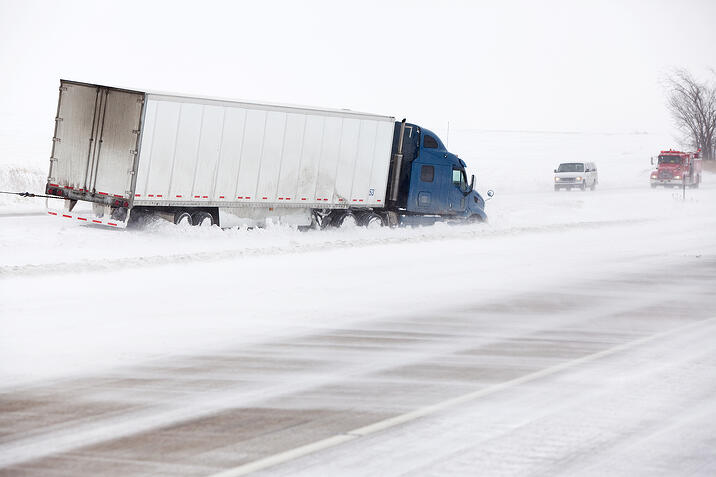
There is an increased risk of jackknifes in winter due to icy roadways, but this type of loss-of-control crash can occur any time of the year. To help avoid a jackknife, or recover from one, drivers must be able to recognize the hazards that can lead to a jackknife and react properly. Read the information below and ask yourself if there are actions you can take to improve your driving skills and reduce the risk of a jackknife.
RECOGNIZE THE HAZARDS
 ENVIROMENT
ENVIROMENT
Slippery road conditions, like black ice, snow, sand, salt, etc., can cause tires to lose traction. Similarly, adverse weather including rain, sleet, snow, etc. can lead to poor visibility and reduce a driver’s ability to identify hazards and react in time.
 EQUIPMENT
EQUIPMENT
Jackknifes can be caused by the tractor or trailer losing rolling traction, meaning the tire’s adhesion or grip to the road surface as the vehicle is moving. If the tractor’s steer tires lock up or the drive wheels slide or spin, it can cause the tractor’s drive wheels to try to lead the steer tires and swing around.
Similarly, the trailer may jackknife for a number of reasons, including insufficient tire tread depth, shifting cargo, a lightly laden or empty trailer, brake failure or improper brake adjustment, a disconnected air hose, or the trailer tandems losing traction and beginning to slide or spin.
![]() PERSONAL BEHAVIOURS
PERSONAL BEHAVIOURS
Truck drivers can inadvertently trigger a jackknife when driving too fast for conditions, braking abruptly, accelerating too fast, or using the engine brake or cruise control on slippery surfaces. In addition, inexperience, distractions, and inattention can cause a driver to overlook the hazards that can lead to a jackknife. This can cause them to react suddenly and turn the steering wheel too sharply.
KNOW THE DEFENSE
![]()
One defense against a jackknife is prevention. Conduct a thorough pre-trip inspection to ensure your equipment is working properly. Be cautious of slippery driving conditions and when pulling an empty or lightly laden trailer. Pay attention to the road ahead while driving and avoid distractions such as talking/texting on the phone or driving while ill or fatigued. Reduce speed in bad weather and leave yourself extra room to execute a controlled stop.
 HOW TO RECOVER FROM A JACKKNIFE
HOW TO RECOVER FROM A JACKKNIFE1. To regain rolling traction, disengage the clutch if using a manual transmission or shift to neutral when using an automatic transmission.
2. Avoid using the brakes.
3. Steer in the direction of the skid, then counter-steer, as needed, to straighten the truck.
As always, you can count on the commercial truck insurance professionals at The Daniel & Henry Company to assist you through challenging claims and all of our insurance, risk management, and safety issues. Contact us today to discuss solutions for your transportation risk management program.


